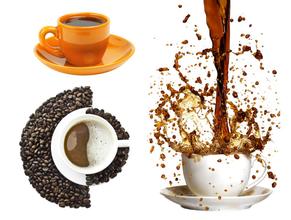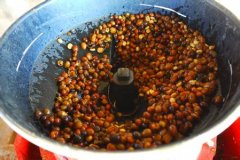A brief introduction to the characteristic Price of Grinding degree by describing the Flavor of Las Haas Manor in Costa Rica

Lajas is also the first manor in Central America to start honey treatment and natural sun treatment. Tanning is a very traditional practice, which uses the least resources, but because there are too many uncontrollable factors, it is very difficult to do well. Francesca has added many innovations, such as using the sugar meter (Brix meter), which is often equipped in the wine industry, to measure the sugar content of the fruit, and to determine the best time and treatment of harvest according to the sugar content of Brix. Only those with more than 20% sweetness will be exposed to the sun. The Brix value of general fruit is 14 for apple, 12 for lemon and 18 for passion fruit, but the coffee cherry in Lajas can reach 21 / 22%.
All the coffee trees planted in Costa Rica are Arabica coffee trees. through improvement, the quality of coffee beans is better and more stable. in order to facilitate picking, coffee trees are kept at a height of about 2 meters through continuous pruning. The coffee that people eat is the taste of the seeds in the fruit that are brewed in water. After picking raw coffee beans, you must remove the peel, pulp, seed film and sun exposure before the seeds (that is, coffee beans) can be roasted. Part of the process can be replaced by machines, and the speed of coffee production increases a lot. However, there is no machine to do coffee picking, so you must use manual labor. Costa Rican coffee has full particles, ideal acidity and unique strong flavor. Costa Rica's coffee industry, originally controlled by the Costa Rican Coffee Industry Company (ICAFE), has been taken over by the official Coffee Committee (Oficinale Cafe). Among the exported coffee, those products that are considered to be of substandard quality are colored with blue vegetable dyes and then transferred back to China for sale. Coffee consumed domestically (dyed blue or undyed) accounts for about 10% of total production, and local per capita coffee consumption is twice that of Italy or the United States.
The Goddess Manor in Costa Rica was established in 1960. What we have to say about this "goddess" rose summer: the goddess is planted by organic farming, naturally shaded by local native trees and fruit trees, and organic fertilizer uses coffee and cherry pulp to mix molasses. Add fertile soil with high mineral content in the adjacent mountain area with microbial fermentation to produce organic fertilizer that can enhance the disease resistance of coffee, and the soil is suitable for California earthworm cultivation.
After the coffee fruit is ripe, it is picked by hand, and only the ripe red-purple berries are picked. The processing method of raw coffee beans is washed with water, which is treated at a very unique constant temperature. The degree of fermentation makes the clarity and complexity of coffee get an excellent balance, and its flavor shows better stability. It is really intoxicating to show the very special flavor of Geisha (Rosa / Geisha).
The natural treatment process of French Sika is quite laborious. The artificially picked high-sugar coffee fruit is first placed in an African viaduct in the sun for about 10 days, and then placed in a plastic-covered greenhouse to create more direct heat and continue to dry. until the water content reaches 11.5%. The slow drying process allows raw beans to develop more natural sweetness from the inside, but it also needs to be taken care of more carefully and constantly turned. In the end, the red cherries turn black, giving off the aroma of fruitcake, black sugar and even sherry. This is the "Perla Negra"!
There are eight Costa Rican producing areas, of which Tarazu, the Central Valley and the Western Valley are recognized as the three best producing areas. Las Lajas is located in the foothills of Sabanilla de Alajuela and Poas Volcano in the Central Valley. Strictly speaking, "Lajas" is actually the name of the Chakon family processing plant. The name of the manor is Finca La Mirella, but bean bakers all over the world are also used to calling it Finca las lajas.
Important Notice :
前街咖啡 FrontStreet Coffee has moved to new addredd:
FrontStreet Coffee Address: 315,Donghua East Road,GuangZhou
Tel:020 38364473
- Prev

Brief introduction of Coffee Flavor description and Grinding scale treatment in Las Haas Manor, Costa Rica
The Goddess Manor in Costa Rica was established in 1960. What we have to say about this "goddess" Rosa Xia: the goddess is planted by organic farming, naturally shaded by local native trees and fruit trees, and organic fertilizer uses coffee and cherry pulp to mix molasses. Add fertile soil with high mineral content in the adjacent mountain area with microbial fermentation to produce organic fertilizer that can enhance the disease resistance of coffee.
- Next

A brief introduction to the characteristics of Grinding scale treatment for Coffee Flavor description in Las Haas Manor, Costa Rica
I have roughly counted that on average, for every new coffee bean released, at least 16 samples will be tested. Only when I encounter coffee that really makes me feel good, I am willing to share it with you. After choosing a raw bean as the release, I also have to test the baking degree, adjust the baking curve, cup test and determine the final flavor. Only in this way can we ensure that the coffee beans can be placed in every
Related
- Does Rose Summer choose Blue, Green or Red? Detailed explanation of Rose Summer Coffee plots and Classification in Panamanian Jade Manor
- What is the difference between the origin, producing area, processing plant, cooperative and manor of coffee beans?
- How fine does the espresso powder fit? how to grind the espresso?
- Sca coffee roasting degree color card coffee roasting degree 8 roasting color values what do you mean?
- The practice of lattes: how to make lattes at home
- Introduction to Indonesian Fine Coffee beans-- Java Coffee producing area of Indonesian Arabica Coffee
- How much will the flavor of light and medium roasted rose summer be expressed? What baking level is rose summer suitable for?
- Introduction to the characteristics of washing, sun-drying or wet-planing coffee commonly used in Mantenin, Indonesia
- Price characteristics of Arabica Coffee Bean Starbucks introduction to Manning Coffee Bean Taste producing area Variety Manor
- What is the authentic Yega flavor? What are the flavor characteristics of the really excellent Yejasuffi coffee beans?

